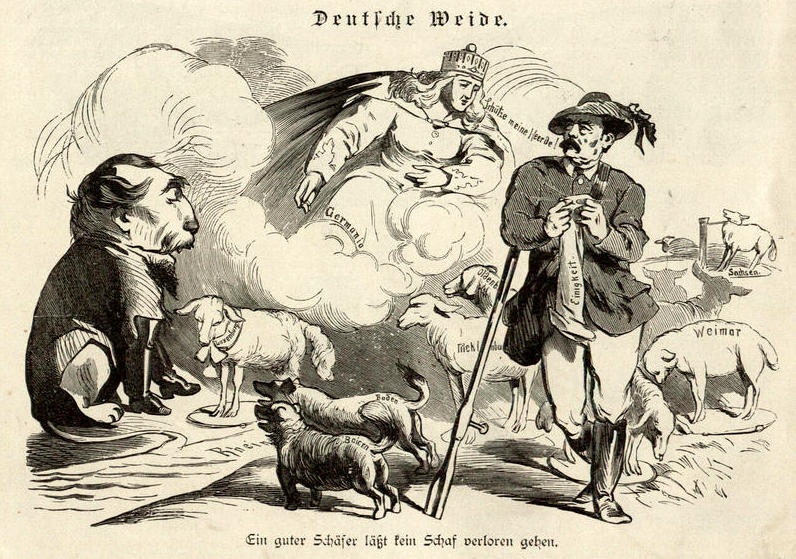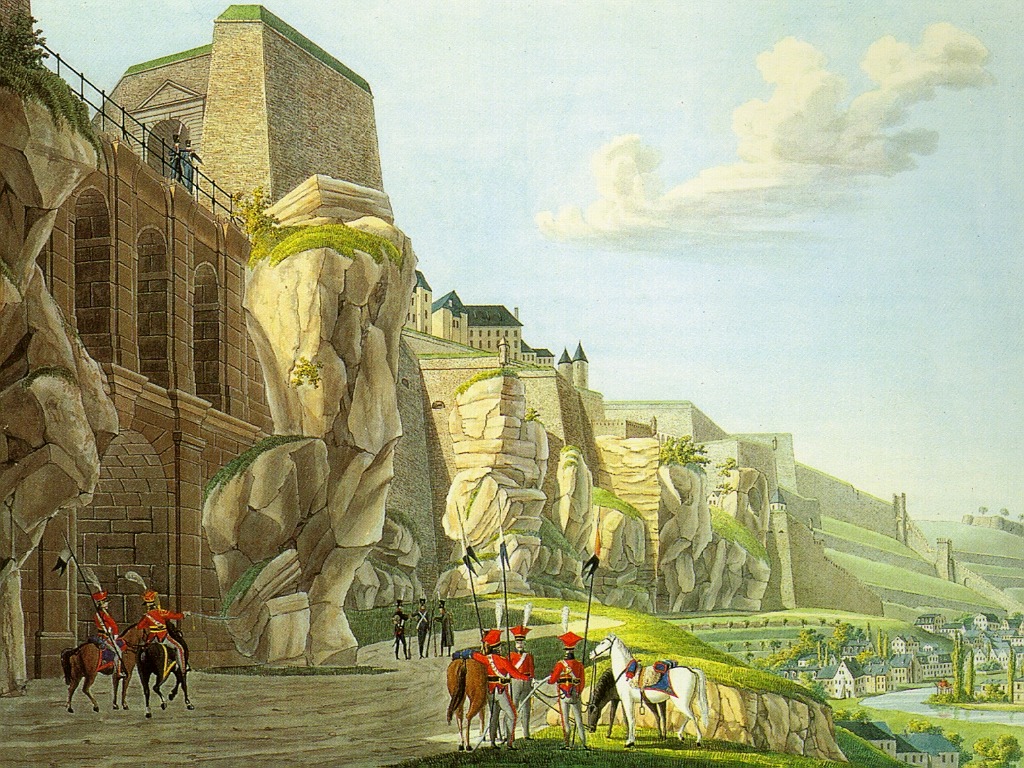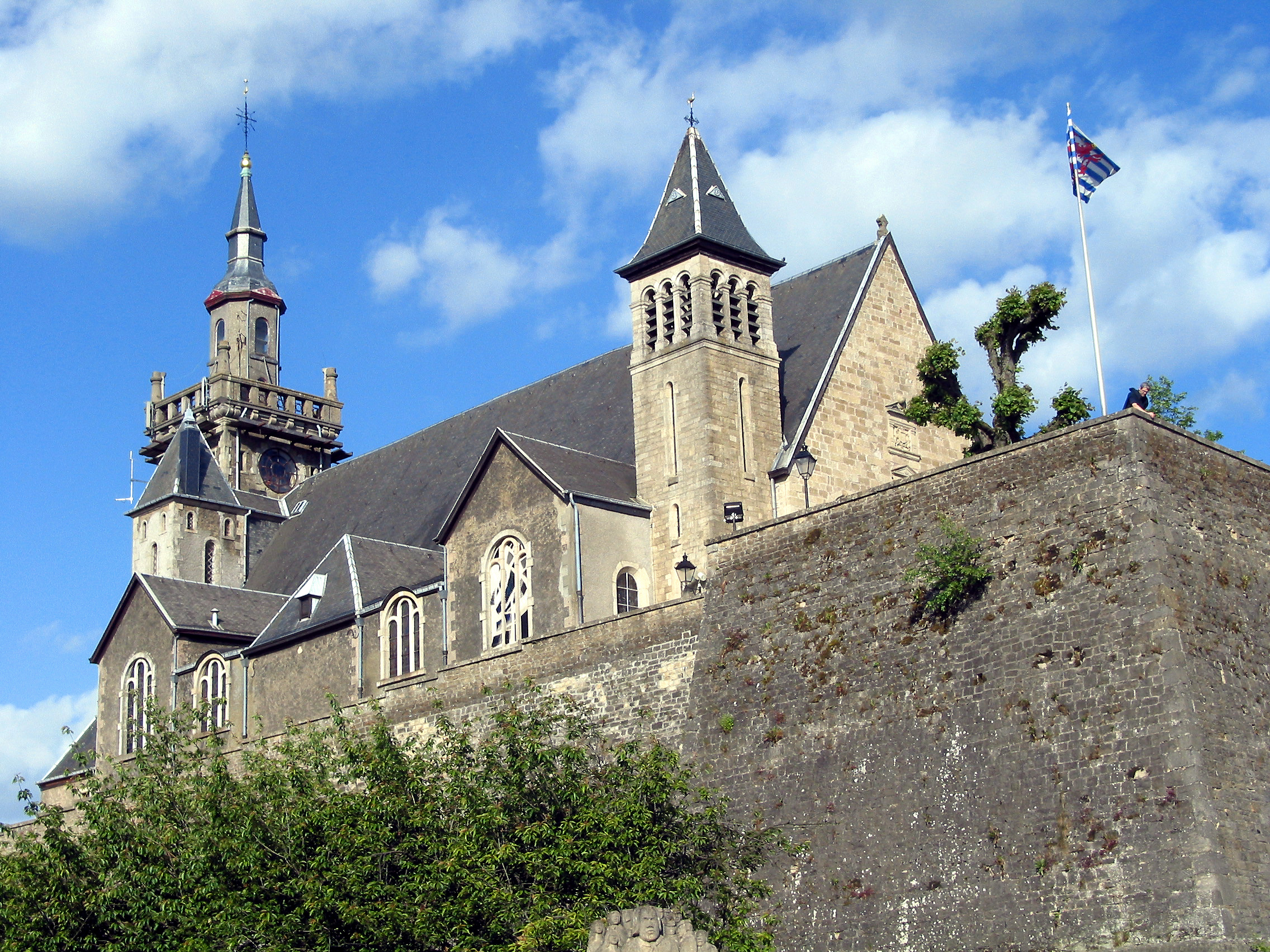|
Fortress Of Luxembourg
The Fortress of Luxembourg is the former fortifications of Luxembourg City, the capital of the Grand Duchy of Luxembourg, which were mostly dismantled beginning in 1867. The fortress was of great strategic importance for the control of the Left Bank of the Rhine, the Low Countries, and the border area between France and Germany. The fortifications were built gradually over nine centuries, from soon after the city's foundation in the tenth century until 1867. By the end of the Renaissance, Luxembourg was already one of Europe's strongest fortresses, but it was the period of great construction in the 17th and 18th centuries that gave it its fearsome reputation. Due to its strategic location, it became caught up in Europe-wide conflicts between the major powers such as the Habsburg–Valois wars, the War of the Reunions, and the French Revolutionary Wars, and underwent changes in ownership, sieges, and major alterations, as each new occupier—the Burgundians, French, Austrian and ... [...More Info...] [...Related Items...] OR: [Wikipedia] [Google] [Baidu] |
Luxembourg Crisis
The Luxembourg Crisis (german: Luxemburgkrise, french: Crise luxembourgeoise) was a diplomatic dispute and confrontation in 1867 between France and Prussia over the political status of Luxembourg. The confrontation almost led to war between the two parties, but was peacefully resolved by the Treaty of London. Background Luxembourg City boasted some of the most impressive fortifications in the world, the Fortress of Luxembourg, partly designed by Marshal Vauban and improved by subsequent engineers, which gave the city the nickname "Gibraltar of the North". Since the 1815 Congress of Vienna, the Grand Duchy of Luxembourg had been in personal union with the Kingdom of the Netherlands. In a concession to neighbouring Prussia, Luxembourg was to be a member of the German Confederation, with several thousand Prussian soldiers stationed there. The Belgian Revolution of 1830 had divided Luxembourg into two, threatening Dutch control of the remaining territory. As a result, William I ... [...More Info...] [...Related Items...] OR: [Wikipedia] [Google] [Baidu] |
Siegfried Of Luxembourg
Sigfried (or Siegfried) ( – 28 October 998) was Count in the Ardennes, and is known in European historiography as founder and first ruler of the Castle of Luxembourg in 963 AD, and ancestor and predecessor of the future counts and dukes of Luxembourg. He was also an advocate of the abbeys of St. Maximin in Trier and Saint Willibrord in Echternach. His male-line descendants are known as the House of Luxembourg, or House of Ardenne–Luxembourg, and his descendants would become the Counts of Luxembourg. Ancestry Through his mother Cunigunde, who was a granddaughter of Louis II, King of West Francia, Sigfried was a sixth-generation descendant of Charlemagne. His father is most likely Count Palatine Wigeric of Lotharingia, the ruler of Lotharingia, which was a successor state of Middle Francia. Wigeric is also considered the founder of the House of Ardennes, and his sons, including Sigfried, would all create their own respective branches and become important rulers in Upper ... [...More Info...] [...Related Items...] OR: [Wikipedia] [Google] [Baidu] |
Bock (Luxembourg)
The Bock ( lb, Bockfiels) is a promontory in the north-eastern corner of Luxembourg City's old historical district. Offering a natural fortification, its rocky cliffs tower above the River Alzette, which surrounds it on three sides. It was here that Count Siegfried built his Castle of ''Lucilinburhuc'' in 963, providing a basis for the development of the town that became Luxembourg. Over the centuries, the Bock and the surrounding defenses were reinforced, attacked, and rebuilt time and time again as the armies of the Burgundians, Habsburgs, Spaniards, Prussians, and French vied for victory over one of Europe's most strategic strongholds, the Fortress of Luxembourg. Warring did not stop until the Treaty of London was signed in 1867, calling for the demolition of the fortifications. Ruins of the old castle and the vast underground system of passages and galleries known as the casemates continue to be a major tourist attraction. History It was in 963 that Count Siegfried, ... [...More Info...] [...Related Items...] OR: [Wikipedia] [Google] [Baidu] |
Thionville
Thionville (; ; german: Diedenhofen ) is a city in the northeastern French department of Moselle. The city is located on the left bank of the river Moselle, opposite its suburb Yutz. History Thionville was settled as early as the time of the Merovingians. After the fall of the Western Roman Empire, the region was inhabited by the Germanic Alamanni. It was known in the Latin of that era as ''Theudonevilla'' or ''Totonisvilla''. King Pepin the Short had a royal palace constructed here. The Synod of Thionville was held here beginning on February 2, 835. It reinstated Emperor Louis the Pious and reversed his former conviction on crimes — none of which he actually committed — and deposed the Archbishop of Rheims, Ebbo. The Synod was composed of 43 bishops. On February 28, 835, in Mainz, Ebbo admitted that Louis had not committed the crimes of which he had been indicted and for which he had been deposed as Holy Roman Emperor. From the 10th century onward, the area ... [...More Info...] [...Related Items...] OR: [Wikipedia] [Google] [Baidu] |
Trier
Trier ( , ; lb, Tréier ), formerly known in English as Trèves ( ;) and Triers (see also names in other languages), is a city on the banks of the Moselle in Germany. It lies in a valley between low vine-covered hills of red sandstone in the west of the state of Rhineland-Palatinate, near the border with Luxembourg and within the important Moselle wine region. Founded by the Celts in the late 4th century BC as ''Treuorum'' and conquered 300 years later by the Romans, who renamed it ''Augusta Treverorum'' ("The City of Augustus among the Treveri"), Trier is considered Germany's oldest city. It is also the oldest seat of a bishop north of the Alps. Trier was one of the four capitals of the Roman Empire during the Tetrarchy period in the late 3rd and early 4th centuries. In the Middle Ages, the archbishop-elector of Trier was an important prince of the Church who controlled land from the French border to the Rhine. The archbishop-elector of Trier also had great signific ... [...More Info...] [...Related Items...] OR: [Wikipedia] [Google] [Baidu] |
Arlon
Arlon (; lb, Arel ; nl, Aarlen ; german: Arel ; wa, Årlon; la, Orolaunum) is a city and municipality of Wallonia located in and capital of the province of Luxembourg in the Ardennes, Belgium. With a population of just over 28,000, it is the smallest provincial capital in Belgium. Arlon is also the capital of its cultural region: the Arelerland (Land of Arlon in Luxemburgish). The municipality consists of the following districts: Arlon, Autelbas, Barnich, Bonnert, Guirsch, Heinsch, and Toernich. Other population centers include: * Autelhaut * Clairefontaine * Fouches * Frassem * Freylange * Hachy * Heckbous * Rosenberg * Sampont * Schoppach * Sesselich * Seymerich * Stehnen * Sterpenich * Stockem * Udange * Viville * Waltzing * Weyler * Wolberg History Roman and medieval times Before the Roman conquests of Gaul, the territory of Arlon and a vast area to the southeast were settled by the Treveri, a Celtic tribe. The local population adapted relatively easily ... [...More Info...] [...Related Items...] OR: [Wikipedia] [Google] [Baidu] |
Pétrusse
The Pétrusse (; lb, Péitruss, german: Petruss) is a river flowing through Luxembourg, joining the Alzette at Luxembourg City. It flows through the town of Hollerich Hollerich ( lb, Hollerech) is a quarter in south-western Luxembourg City, in southern Luxembourg. , the quarter has a population of 7,132 inhabitants. Hollerich railway station is located on Chemins de Fer Luxembourgeois Line 70, which conne .... Rivers of Luxembourg {{Luxembourg-river-stub ... [...More Info...] [...Related Items...] OR: [Wikipedia] [Google] [Baidu] |
Alzette
The Alzette (; ; ) is a river with a length of in France and Luxembourg. It is a right tributary of the Sauer (a tributary to the Moselle), and ultimately to the Rhine. It rises in Thil near the town Villerupt in the Meurthe-et-Moselle ''département'', France. It crosses the border with Luxembourg after . At Lameschmillen (near Bergem) it is joined by the Mess. It flows through the Luxembourgish towns Esch-sur-Alzette, Luxembourg City and Mersch, and empties into the Sauer near Ettelbruck. The rocky cliffs above the Alzette in Luxembourg are called 'Bock'. This name was given to the Casemates du Bock; a honeycomb of tunnels colloquially named 'Paula', which runs under the ruins of the Fortress of Luxembourg. It protected Luxembourg City Luxembourg ( lb, Lëtzebuerg; french: Luxembourg; german: Luxemburg), also known as Luxembourg City ( lb, Stad Lëtzebuerg, link=no or ; french: Ville de Luxembourg, link=no; german: Stadt Luxemburg, link=no or ), is the capital city of ... [...More Info...] [...Related Items...] OR: [Wikipedia] [Google] [Baidu] |
World Heritage Site
A World Heritage Site is a landmark or area with legal protection by an international convention administered by the United Nations Educational, Scientific and Cultural Organization (UNESCO). World Heritage Sites are designated by UNESCO for having cultural, historical, scientific or other form of significance. The sites are judged to contain " cultural and natural heritage around the world considered to be of outstanding value to humanity". To be selected, a World Heritage Site must be a somehow unique landmark which is geographically and historically identifiable and has special cultural or physical significance. For example, World Heritage Sites might be ancient ruins or historical structures, buildings, cities, deserts, forests, islands, lakes, monuments, mountains, or wilderness areas. A World Heritage Site may signify a remarkable accomplishment of humanity, and serve as evidence of our intellectual history on the planet, or it might be a place of great natural beauty. A ... [...More Info...] [...Related Items...] OR: [Wikipedia] [Google] [Baidu] |
UNESCO
The United Nations Educational, Scientific and Cultural Organization is a specialized agency of the United Nations (UN) aimed at promoting world peace and security through international cooperation in education, arts, sciences and culture. It has 193 member states and 12 associate members, as well as partners in the non-governmental, intergovernmental and private sector. Headquartered at the World Heritage Centre in Paris, France, UNESCO has 53 regional field offices and 199 national commissions that facilitate its global mandate. UNESCO was founded in 1945 as the successor to the League of Nations's International Committee on Intellectual Cooperation.English summary). Its constitution establishes the agency's goals, governing structure, and operating framework. UNESCO's founding mission, which was shaped by the Second World War, is to advance peace, sustainable development and human rights by facilitating collaboration and dialogue among nations. It pursues this objective t ... [...More Info...] [...Related Items...] OR: [Wikipedia] [Google] [Baidu] |
Neutral Country
A neutral country is a state that is neutral towards belligerents in a specific war or holds itself as permanently neutral in all future conflicts (including avoiding entering into military alliances such as NATO, CSTO or the SCO). As a type of non-combatant status, nationals of neutral countries enjoy protection under the law of war from belligerent actions to a greater extent than other non-combatants such as enemy civilians and prisoners of war. Different countries interpret their neutrality differently: some, such as Costa Rica, have demilitarized, while Switzerland holds to "armed neutrality", to deter aggression with a sizeable military, while barring itself from foreign deployment. Not all neutral countries avoid any foreign deployment or alliances, as Austria and Ireland have active UN peacekeeping forces and a political alliance within the European Union. Sweden's traditional policy was not to participate in military alliances, with the intention of staying neutral in t ... [...More Info...] [...Related Items...] OR: [Wikipedia] [Google] [Baidu] |





